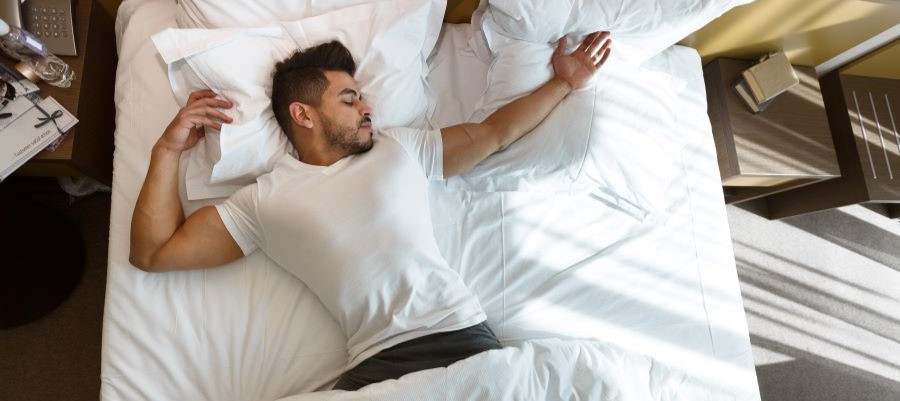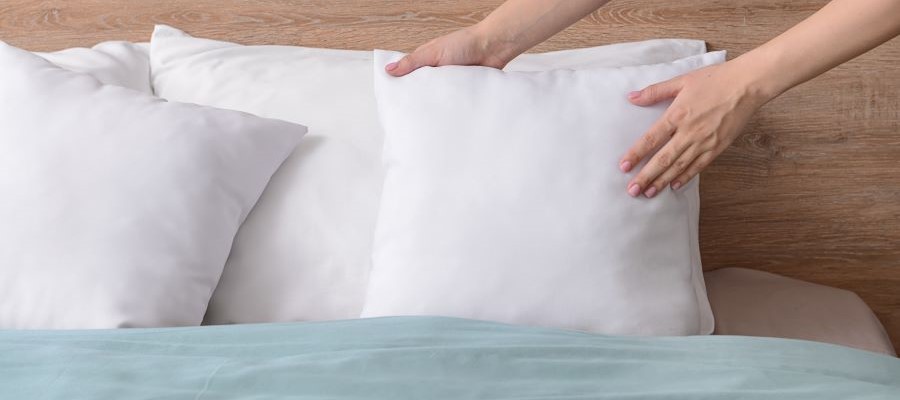Best Pillow for your Sleep Style
Do you use the best pillow suited for your individual sleep style? We spend up to a third of our lives asleep so it’s no stretch of the imagination to conclude that your pillow is going to play a huge role in how well you sleep.
Why pillow type is important to your sleep health
One of the key purposes of a pillow is to help align our body from head to hips in correct posture while we sleep. Identifying your prominent sleep position is the first step in figuring out your ideal pillow.

Sleeping Positions
There are three main sleep positions, although within each position, there are additional sleeping styles that can be identified.
Back sleepers
This position refers to people who spend the majority of their night sleeping on their backs, also known as a supine position. It is the second most common way people sleep, after side sleepers.
Sleeping on your back can reduce back pain and relieve pressure from your joints equally. It is helpful in reducing nasal congestion as well. For those who snore or suffer from sleep apnea, back sleeping can exacerbate these symptoms as it is the easiest position for the tongue to fall back when relaxed and block the airway.
Side sleepers
Side sleeping is the most common sleep position, making up anywhere from 55% to 74% of sleepers. There are many pros to sleeping on your side.
- It can reduce symptoms of acid reflux and gastroesophageal reflux disease (GERD). Sleeping on your left side can reduce stomach acids from reaching your esophagus, preventing episodes of acid reflux and GERD.
- If you are pregnant, your doctor will likely suggest sleeping on your side, especially once you reach your third trimester. This position provides optimal blood flow, allowing the best circulation and transfer of nutrients to the placenta.
- For people who snore, side sleeping can reduce snoring by helping keep your airways open.
- It can help reduce back pain, especially if you have the proper supportive pillows for your neck and legs.
Stomach sleepers
This is by far the least common sleep position. Sleeping on your stomach can put strain on your spine from the natural pull of gravity on your torso. If you suffer from back pain, sleeping on your stomach is the worst sleep position. Stomach sleeping can also cause stiffness in the neck, as most stomach sleepers will turn their neck to one side in order to breathe. Remaining in this position with your next twisted to one side for a prolonged period can also put strain on your shoulders, causing soreness and pain.

Read also: How much sleep do I need?
How does a pillow affect my sleep?
When you were a child, did an adult ever tell you to sit up straight or to stand tall, to not slouch or hunch your shoulders? Good posture helps to alleviate pain and tension, improve circulation and proper muscle development.
Similarly, good sleep posture can affect many of these same symptoms and functions while you sleep. In order to achieve and maintain good sleep posture, the proper pillow will provide support from your head to your hips. With the right pillow and good sleep routine, you may notice an immediate difference in the way you feel during the day, after a good night’s sleep!

Types of pillows
If you haven’t gone pillow shopping in a while, it may surprise you just how many different pillows are on the market. There are a number of considerations when selecting the best pillow for you. Pillows come in every combination of size, temperature regulation, fill weight and type of filling (density).
Size
The most common pillow size is the standard pillow (20” x 26”) and queen pillow (20” x 28” or 20” x 30”) Then there is the king pillow (20” x 36”), the euro pillow (26” x 26”), the body pillow (usually about 20” x 50”).
Temperature regulations
If you tend to sleep hot, the outer material of your pillow will be especially important. Fill materials such as latex and down offer a higher level of breathability and airflow, which will keep your pillow cooler.
There are also pillow options that include a cooling gel layer that will further keep your head cooler throughout the night.
Fill weight and density
The weight and density of your pillow will determine how comfortable the pillow feels under your head as well as how long your pillow should last before it needs to be replaced.
Fill weight refers to the amount of filling in your pillow. A higher fill weight could make for a more durable pillow and one that offers proper neck support throughout your sleep.
Fill density refers to how firm the pillow is and how it responds to your body. You will typically find pillows rated as being soft, medium, or firm. Down or down alternatives start one end of the spectrum having a lighter density and are usually soft pillows. Memory foam or latex pillows are usually in the middle with a medium density and level of firmness. On the other end of the spectrum are firm pillows with high density, such as wool and cotton filled pillows.

Read also: Sleep during pregnancy
Finding your perfect pillow match
Back sleepers
If you spend most of the night sleeping on your back, you will want a medium thick, medium firm pillow that provides ample support for your head and neck and spine.
Side sleepers
For side sleepers, a denser, high pillow will be best. It is important to check the angle of your neck once you have had your head on your pillow for a while. If your head sinks into your pillow, causing a bend in your neck, over the course of the night, the prolonged misalignment from your neck through your spine could cause neck and back pain.
If you have shoulder pain upon waking, it may be because your pillow is not high enough which is putting too much pressure on your shoulder as it digs into your mattress.
Stomach sleepers
Stomach sleepers already put a lot of pressure on their back and spine so it may actually be best to not use a pillow at all. Elevating the head will create an even greater angle from the head to the neck to the spine. If you must, choose a pillow that is very low and soft.

When should you replace your pillow?
Typically, pillows should be replaced every 1-2 years. If it’s been a while since you replaced your pillows, here are some signs that you should look at getting new pillows:
- You regularly wake up with neck pain and/or a headache.
- Your pillow is stained – this is natural as we sweat and release oils during sleep, which accumulates on our pillows and bedding.
- Your pillow has a permanent indent from your head that doesn’t go away when you try fluffing it.
- It fails the pillow bend test: fold your pillow in half. What happens when you let it go? If it bounces back to its original shape, it’s good. If it doesn’t, its time to replace it.
Another reason to change your pillow is because you’ve changed your dominant sleep position. Maybe you used to sleep primarily on your back but you’ve switched to sleeping on your side to help reduce snoring. The pillow you used as a back sleeper is likely not the right pillow for you now as a side sleeper.
Disclaimer: none of the above is shared as medical advice. Consult your primary physician if you have severe pain upon waking in the morning.


